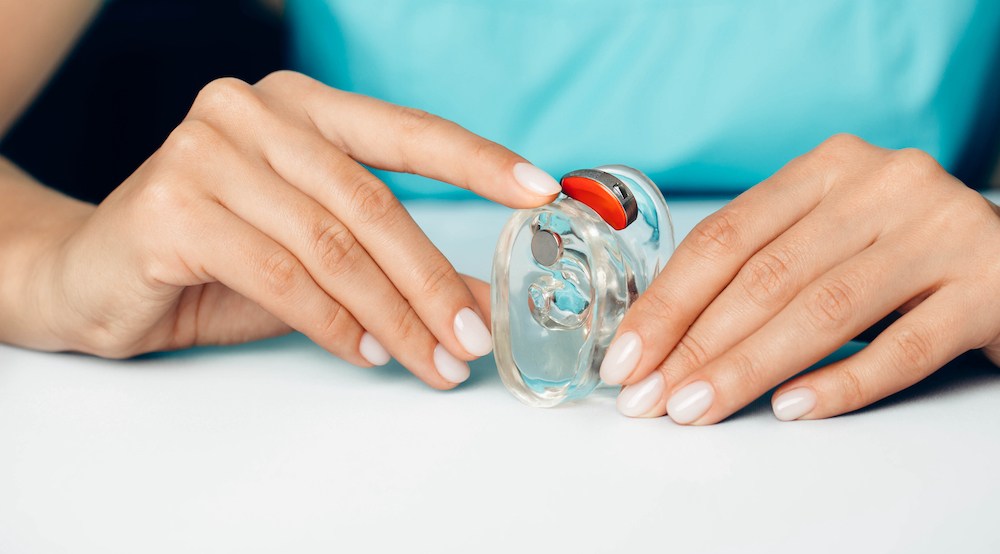The Benefits of Fall Hearing Health Check-Ups
As the seasons shift and temperatures drop, many people start to think

By: admin | January 26, 2025
Cold and flu season brings extra challenges when you wear hearing aids. The cooler temperatures and increased moisture in the air don’t just affect your health – they can impact how well your hearing aids work too. Congestion, ear infections and general illness can temporarily change how you hear, while the dampness from rain and snow can affect your hearing aids’ performance.
During these months, you might notice changes in how your hearing aids function or how well you hear with them. Between wiping runny noses and dealing with seasonal illness, the last thing you want to worry about is whether your hearing aids are working properly.
Taking care of both your health and your hearing aids during cold and flu season helps you stay connected when you need it most. Simple steps can protect your hearing aids from moisture damage while managing seasonal health challenges.
Cold weather can create unique challenges for hearing aid users, as lower temperatures affect both the functionality and comfort of these devices. One of the primary issues is the impact of cold temperatures on battery performance. Hearing aid batteries, especially zinc-air batteries, rely on a chemical reaction to generate power. Cold weather slows down this reaction, causing batteries to drain faster than usual. If you’re spending extended time outdoors in colder conditions, you may find that your hearing aids require more frequent battery replacements or recharging.
In addition to battery efficiency, cold weather can affect the materials used in hearing aids. Many devices are made of plastic and metal components that can contract in cold temperatures. This contraction might alter the fit of the hearing aids, causing them to feel less secure or uncomfortable. For individuals with sensitive skin, cold air can also make wearing behind-the-ear models uncomfortable, as the skin in contact with the device can become irritated or dry.
Moving between cold outdoor air and warm indoor environments can also cause condensation to form inside the hearing aids. While this isn’t always immediately noticeable, moisture buildup can disrupt the electrical components, leading to temporary malfunctions or reduced sound quality. Over time, repeated exposure to temperature fluctuations without proper care can increase the risk of damage to the internal parts of the hearing aids.
Cold weather also poses challenges for managing hearing aid settings. Dexterity can be an issue when adjusting small controls on hearing aids, especially if you’re wearing gloves. Touchscreen apps or remote controls designed for hearing aids can help address this issue, offering a more convenient way to make adjustments without exposing your hands to the cold.
Flu season doesn’t just bring fevers and body aches – it can also affect your hearing health. Infections like the flu can cause inflammation throughout the body, including in the ear. This inflammation may lead to temporary hearing difficulties, like muffled sounds or a sense of fullness in the ears, often due to fluid buildup in the middle ear.
Viruses like the flu can also sometimes impact the auditory nerve or inner ear, leading to sudden changes in hearing or a ringing sensation known as tinnitus. While these symptoms are often temporary, they can interfere with your ability to hear clearly and communicate comfortably during your daily activities.
It’s also common for flu symptoms like nasal congestion or sinus pressure to block the Eustachian tubes, which are responsible for regulating pressure in your ears. When these tubes are obstructed, it can cause discomfort, temporary hearing loss, or even dizziness.
In warmer climates like Texas, where weather conditions don’t necessarily limit outdoor activity during flu season, you may still encounter busy, crowded environments where viruses spread easily. Taking steps to prevent the flu – like getting vaccinated, washing your hands regularly and avoiding close contact with sick individuals – not only protects your overall health but also helps safeguard your hearing during this time. If you notice hearing changes that don’t improve after flu symptoms subside, it’s a good idea to consult an audiologist.
When thinking about flu season, hygiene is often top of mind for preventing the spread of germs and staying healthy. However, hygiene isn’t just about washing your hands or disinfecting surfaces – it’s also essential for keeping your hearing aids in top condition during this time. With the flu and other illnesses circulating, your hearing aids may come into contact with germs, earwax and moisture more frequently, all of which can impact their performance.
Cleaning your hearing aids regularly is crucial to ensuring they function optimally. Earwax, debris or moisture can accumulate on the microphone, speaker or vents of your devices, potentially blocking sound and reducing clarity. During flu season, these issues may become more common as congestion and increased earwax production can go hand in hand with seasonal illnesses. By gently wiping down your hearing aids with a soft, dry cloth and using the appropriate tools to clear vents or wax guards, you can prevent these build-ups and keep your devices working seamlessly.
Maintaining proper hygiene for your hearing aids also helps extend their lifespan. Moisture and debris can not only interfere with sound transmission but may also lead to damage or corrosion of sensitive internal components. Using a dehumidifier or drying case at night can help remove any residual moisture, especially if you’ve been outdoors or in humid conditions.
Don’t forget the importance of cleaning your hearing aid accessories, like earmolds, tubing or rechargeable cases. These components can also collect bacteria or viruses during flu season, making regular cleaning a necessary part of your routine. Whether you use a specialized hearing aid cleaning kit or follow the guidelines provided by your audiologist, prioritizing hygiene ensures your devices remain reliable, even during the challenges of flu season.
Just as you adjust to the cold weather, your hearing aids too need some special attention during winter. The problem of condensation is a common one that can occur due to the fluctuating temperatures between indoor and outdoor environments.
With the arrival of winter, it’s important to keep a close eye on your hearing aid batteries. The cold weather can affect their lifespan, causing them to drain more quickly than usual. This is due to the low temperatures reducing the battery’s ability to provide power efficiently. So, during these chilly months, you may find yourself needing to replace your hearing aid batteries more frequently.
Being proactive about monitoring your hearing aid battery life is key during this season. Regularly check your battery status and keep a supply of fresh batteries on hand. If you notice that your hearing aids are not performing as well as they usually do, it might be an indication that the batteries need replacing. By staying vigilant about your battery life during winter, you can ensure that your hearing aids continue functioning optimally, keeping you connected with all the sounds of life around you.
While Texas winters may not bring extreme cold, the cooler temperatures and fluctuating weather still present challenges for your hearing aids. Even in milder climates, temperature changes and moisture can impact their performance, making it important to take precautions to keep your devices working at their best.
Cooler air can affect the materials and batteries in your hearing aids. Batteries tend to drain faster in lower temperatures, so it’s a good idea to keep spare batteries on hand or ensure rechargeable devices are fully charged. Additionally, moving between cooler outdoor air and warmer indoor spaces can lead to condensation forming inside your devices. This moisture, even in small amounts, can interfere with sound clarity and potentially cause long-term damage if not addressed.
When heading outdoors, protect your hearing aids by wearing weather-appropriate accessories like hats or scarves. These not only keep you warm but also shield your devices from the wind and cooler air. Once you’re back indoors, wipe down your hearing aids with a soft cloth to remove any moisture and consider placing them in a dehumidifier overnight to ensure they stay dry.
If your hearing aids are not functioning as well as usual during colder months or if you’re noticing any changes in sound quality, it may be time to see your audiologist for an evaluation.
One common issue in winter is battery drain. If your hearing aids are consuming batteries more quickly than usual, it could be due to the cold temperatures, which cause batteries to deplete faster. An audiologist can help troubleshoot this issue and may recommend more suitable battery types or provide tips for extending battery life in colder conditions.
Another sign it’s time to visit your audiologist is if you notice persistent feedback, distortion or muffled sounds. This can often be caused by moisture buildup inside the device, which may occur from transitioning between outdoor cold air and indoor warmth. An audiologist can clean your devices, check for any moisture damage and provide tips on keeping your hearing aids dry during the winter months.
If your hearing aids feel uncomfortable or aren’t fitting properly due to changes in temperature or swelling from wearing winter gear, your audiologist can adjust the fit to ensure optimal comfort.
During cold and flu season, it’s easy to overlook how much the weather and illness can affect your hearing aids. But with a little care and attention, you can keep your devices functioning well and maintain the clear hearing you rely on every day. If you notice any changes in performance or if your hearing aids aren’t working as expected, don’t hesitate to reach out for help. At Acoustics Hearing Centers, we’re here to assist you with any adjustments or troubleshooting you might need.
If you’re in Midland, give us a call at (432) 400-3319, or if you’re in Odessa, reach out at (432) 360-2019. We’re ready to ensure that both your health and your hearing stay in top shape this season, so you can stay connected and enjoy clear hearing all year long.
Tags: hearing aid basics, hearing aid repair, hearing aid styles

As the seasons shift and temperatures drop, many people start to think
By: admin | November 18, 2025

Your hearing aids are pretty impressive pieces of technology, but they
By: admin | September 24, 2025

Your ears can tell a surprising story about your overall health. While we
By: admin | May 23, 2025
